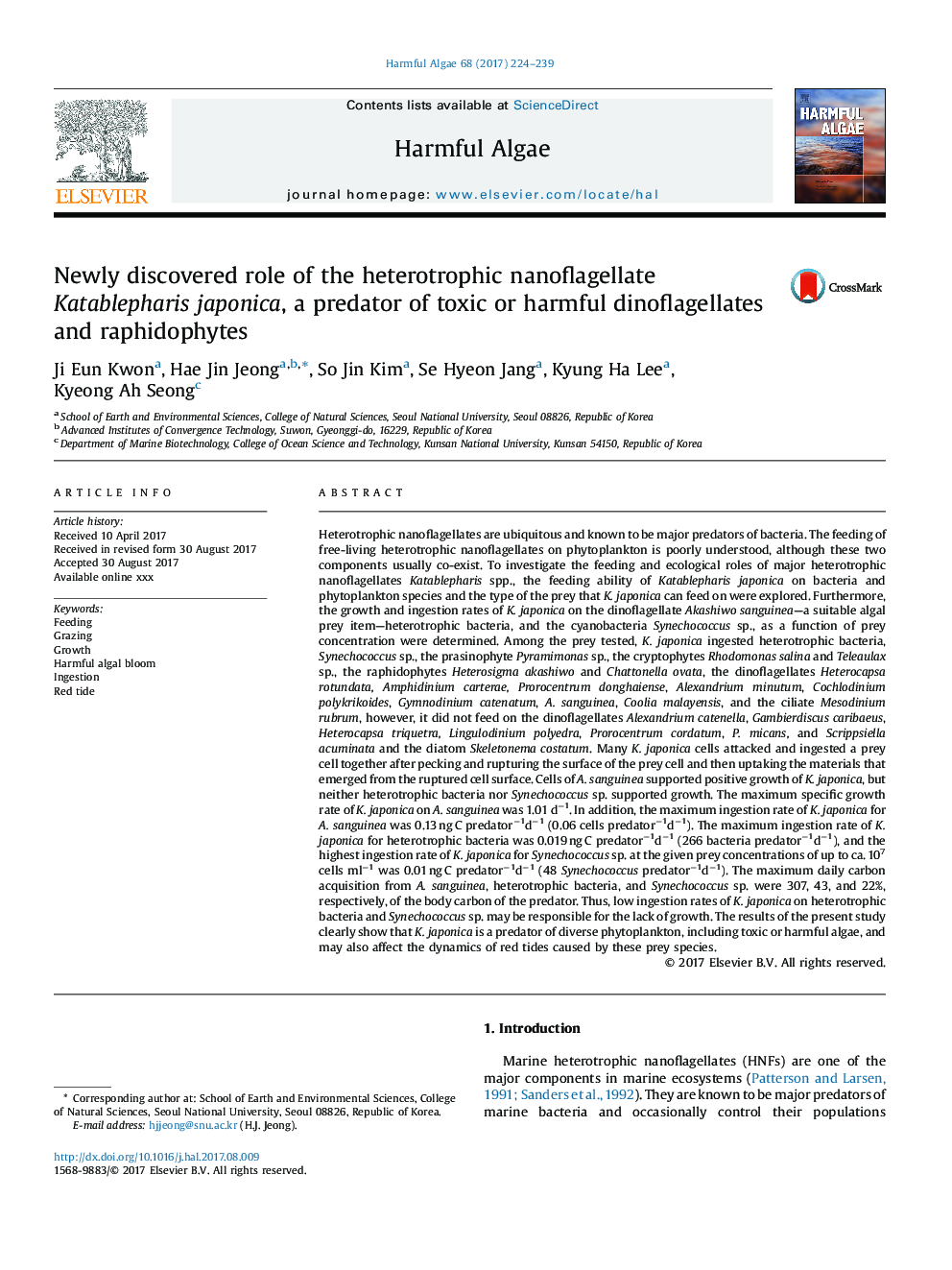| کد مقاله | کد نشریه | سال انتشار | مقاله انگلیسی | نسخه تمام متن |
|---|---|---|---|---|
| 5765767 | 1626904 | 2017 | 16 صفحه PDF | دانلود رایگان |
عنوان انگلیسی مقاله ISI
Newly discovered role of the heterotrophic nanoflagellate Katablepharis japonica, a predator of toxic or harmful dinoflagellates and raphidophytes
دانلود مقاله + سفارش ترجمه
دانلود مقاله ISI انگلیسی
رایگان برای ایرانیان
کلمات کلیدی
موضوعات مرتبط
علوم زیستی و بیوفناوری
علوم کشاورزی و بیولوژیک
علوم آبزیان
پیش نمایش صفحه اول مقاله

چکیده انگلیسی
Heterotrophic nanoflagellates are ubiquitous and known to be major predators of bacteria. The feeding of free-living heterotrophic nanoflagellates on phytoplankton is poorly understood, although these two components usually co-exist. To investigate the feeding and ecological roles of major heterotrophic nanoflagellates Katablepharis spp., the feeding ability of Katablepharis japonica on bacteria and phytoplankton species and the type of the prey that K. japonica can feed on were explored. Furthermore, the growth and ingestion rates of K. japonica on the dinoflagellate Akashiwo sanguinea-a suitable algal prey item-heterotrophic bacteria, and the cyanobacteria Synechococcus sp., as a function of prey concentration were determined. Among the prey tested, K. japonica ingested heterotrophic bacteria, Synechococcus sp., the prasinophyte Pyramimonas sp., the cryptophytes Rhodomonas salina and Teleaulax sp., the raphidophytes Heterosigma akashiwo and Chattonella ovata, the dinoflagellates Heterocapsa rotundata, Amphidinium carterae, Prorocentrum donghaiense, Alexandrium minutum, Cochlodinium polykrikoides, Gymnodinium catenatum, A. sanguinea, Coolia malayensis, and the ciliate Mesodinium rubrum, however, it did not feed on the dinoflagellates Alexandrium catenella, Gambierdiscus caribaeus, Heterocapsa triquetra, Lingulodinium polyedra, Prorocentrum cordatum, P. micans, and Scrippsiella acuminata and the diatom Skeletonema costatum. Many K. japonica cells attacked and ingested a prey cell together after pecking and rupturing the surface of the prey cell and then uptaking the materials that emerged from the ruptured cell surface. Cells of A. sanguinea supported positive growth of K. japonica, but neither heterotrophic bacteria nor Synechococcus sp. supported growth. The maximum specific growth rate of K. japonica on A. sanguinea was 1.01 dâ1. In addition, the maximum ingestion rate of K. japonica for A. sanguinea was 0.13 ng C predatorâ1dâ1 (0.06 cells predatorâ1dâ1). The maximum ingestion rate of K. japonica for heterotrophic bacteria was 0.019 ng C predatorâ1dâ1 (266 bacteria predatorâ1dâ1), and the highest ingestion rate of K. japonica for Synechococcus sp. at the given prey concentrations of up to ca. 107 cells mlâ1 was 0.01 ng C predatorâ1dâ1 (48 Synechococcus predatorâ1dâ1). The maximum daily carbon acquisition from A. sanguinea, heterotrophic bacteria, and Synechococcus sp. were 307, 43, and 22%, respectively, of the body carbon of the predator. Thus, low ingestion rates of K. japonica on heterotrophic bacteria and Synechococcus sp. may be responsible for the lack of growth. The results of the present study clearly show that K. japonica is a predator of diverse phytoplankton, including toxic or harmful algae, and may also affect the dynamics of red tides caused by these prey species.
ناشر
Database: Elsevier - ScienceDirect (ساینس دایرکت)
Journal: Harmful Algae - Volume 68, September 2017, Pages 224-239
Journal: Harmful Algae - Volume 68, September 2017, Pages 224-239
نویسندگان
Ji Eun Kwon, Hae Jin Jeong, So Jin Kim, Se Hyeon Jang, Kyung Ha Lee, Kyeong Ah Seong,